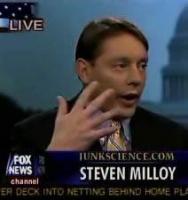For someone who fights Junk Science, Steve Milloy sure likes to spread… well, the junk science.
Remember the story a while ago about the lady who paid over $2000 to have the mercury cleaned up when she accidently smashed a compact fluorescent light bulb (CFL‘s)? If not, here’s the alarmist piece Steve Milloy wrote for Fox News on the matter.
According to most reports on mercury and CFL‘s this lady was most likely a victim of a dubious clean-up crew than she was of mercury poisoning. Energystar reports that the amount of mercury in a CFL is about 100 times less than that found in your average thermometer (pdf).
Here’s the Environmental Protection Agency’s guidelines for cleaning up a broken CFL:
What to Do if a Fluorescent Light Bulb Breaks
Fluorescent light bulbs contain a very small amount of mercury sealed within the glass tubing. EPA recommends the following clean-up and disposal guidelines:
-
Open a window and leave the room for 15 minutes or more.
-
Carefully scoop up the fragments and powder with stiff paper or cardboard and place them in a sealed plastic bag.
-
Use disposable rubber gloves, if available (i.e., do not use bare hands). Wipe the area clean with damp paper towels or disposable wet wipes and place them in the plastic bag.
-
Do not use a vacuum or broom to clean up the broken bulb on hard surfaces.
-
-
Place all cleanup materials in a second sealed plastic bag.
-
Place the first bag in a second sealed plastic bag and put it in the outdoor trash container or in another outdoor protected area for the next normal trash disposal.
Note: Some states prohibit such trash disposal and require that broken and unbroken lamps be taken to a local recycling center. -
Wash your hands after disposing of the bag.
-
-
If a fluorescent bulb breaks on a rug or carpet:
-
First, remove all materials you can without using a vacuum cleaner, following the steps above. Sticky tape (such as duct tape) can be used to pick up small pieces and powder.
-
If vacuuming is needed after all visible materials are removed, vacuum the area where the bulb was broken, remove the vacuum bag (or empty and wipe the canister) and put the bag or vacuum debris in two sealed plastic bags in the outdoor trash or protected outdoor location for normal disposal.
-
Milloy labels similar procedures as “pretty intense” and adds:
“The only step the Maine DEP left off was the final one: Hope that you did a good enough cleanup so that you, your family and pets aren’t poisoned by any mercury inadvertently dispersed or missed.”
Others would disagree with Milloy’ overzealous assessment.
If Milloy’s JunkScience career ever ends maybe he should think about taking over for Joe Rogan on Fear Factor.
Subscribe to our newsletter
Stay up to date with DeSmog news and alerts






